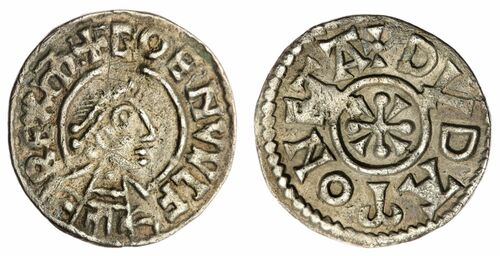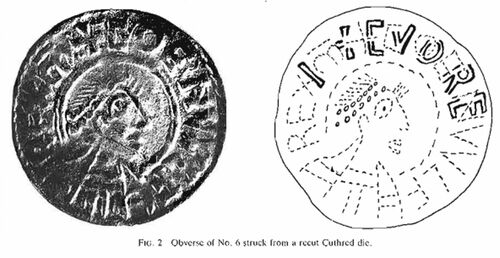Auction: 23005 - The "Haddenham" Collection of English Coins
Lot: 142
The 'Haddenham' Collection of English Coins | Mercia, Coenwulf (796-821), Group II, 'Cross and Wedges' Type, Penny, c. 807, Canterbury, Duda, recut from Cuthred dies, + COENVVLF REX M [over CVÐRED], diademed and draped 'Romanised' bust right, eyes heaven-bound in piety or divinity [?], rev. + DVDA MONETA, cross and wedges in angles, [Spink XRF: 94.60% Ag; 4.21% Cu; 0.720% Pb; 0.476% Au], 1.33g [20.53grns], 2h (Naismith C24a = EMC 1984.0006 this coin; EMC 2002.0266 [Saffron Walden], same obverse die; EMC 2014.0281 [Alfriston] same obverse die; Naismith, "Kingship and Learning on the Broad Penny Coinage of the Mercian Supremacy", in 'New Perspectives' [2011], pp. 70-71 this coin mentioned; North 344; Spink 915), light surface marks and porosity from past soil deposition, the surfaces since unfortunately 'restored' thus the retoning somewhat artificial, otherwise of good and stable fabric, the recut Cuthred obverse die beautifully clear and here paired with an evidently exhausted reverse matrix presumably also dating from the reign of Cuthred, extremely rare and of great significance in the numismatic sequencing of the Mercian hegemony in the Kingdom of Kent, one of only three recorded of this exceedingly unusual practice of 'overwriting' Heptarchic-era coinage dies at Canterbury, this being the now well-published 1983 discovery specimen
Provenance
T Mathews, by private treaty, 2000 - £620
SNC, October 1997, no. 4944* - "almost very fine, rare" - £675
SNC, February 1995, no. 99* - "almost very fine, rare" - £700
SNC, November 1993, no. 7823 - "wt. 1.363g, slightly weak obverse, otherwise about very fine, and rare
- £750 - then subsequently cleaned
BNJ Coin Register 1984, Blackburn and Bonser, no. 6 this coin, in which the following transcription is appended:
"Found by a metal detector user in a field at Colney, near Norwich, late in 1983. The finder kindly supplied us with photographs and subseqently brought us the coin to study. Coenwulf of Mercia, Cross and Wedges type, c. 805/7-c. 810 (North 344). Canterbury, moneyer Duda. Obv. + COENVVLF/REX M Rev. +DVDA MONETA, Weight: 1.40g (21.6gr.). Die-axis: not recorded. Duda, a Canterbury moneyer, struck coins of the Tribrach type for Coenwulf and Cuthred of Kent in the period c. 798-805 and coins of the Cross-and-Wedges type for Cuthred c. 805-7, but he was not hitherto
known to have struck coins of that type in the name of Coenwulf c. 805/7-810. Instead he appears to have had his own distinctive Cross-and-Quatrefoil design, the small flans indicating that they belong before c. 810. However, the new coin from Colney shows that he did briefly use the Cross-and-Wedges type under Coenwulf, before adopting the other design. A close examination of the obverse reveals that under the legend there was an earlier one which can be read +CVBRE[ ]I[ ] for +Cuthred rex / Canl (Fig. 2). The coin was probably struck from an altered die of Cuthred, rather than being overstruck on a Cross-and-Wedges coin of his, for there are no signs of overstriking on the bust or on the reverse, and there would be no reason to restrike coins which evidently belonged to the same issue. There is one other coin of this type, by the moneyer Eaba, which also appears to have been struck from an altered Cuthred die." It has been suggested that Coenwulf and Cuthred shared access to the Canterbury mint, but it seems more likely that between c. 800 or a little later and his death in 807, Cuthred operated the Canterbury mint to the exclusion of Coenwulf.'' On Cuthred's death Coenwulf resumed control of the mint, and the Duda and Eaba coins presumably belong to the period immediately following this."
Found at Colney (Norfolk), late 1983
~ Recorded with the Fitzwilliam Museum, ref. EMC 1984.0006 ~
Interestingly no Cuthred coin can be traced with the unaltered obverse die at Canterbury, but both the Saffron Walden (2002) and Alfriston (2014) finds present different reverse dies. This probably suggests that the reverse die encountered on the present specimen had almost been exhausted during the reign of Cuthred, but was still just about serviceable at the time of his demise and Coenwulf's revisions at the mint. Consequently the obverse may well have been quite new at this point of transition, to account for why Dudda decided to simply recut the obverse legends rather than scrap the matrix altogether. In comparison to the other contemporary moneyers, not only is the classical canon so heavily apparent, but as too is the hand of this portrait engraver and its stylistic similarities to that used for cutting the dies of Wærheard (cf. EMC 2013.0009). As Naismith notes: 'They were presumably struck in the immediate aftermath of the death of Cuthred in 807, and provide a good illustration of the significance attached to the name, but not the portrait that appeared on coinage at this time."
For further reading, see: "Single Finds of Anglo-Saxon and Norman Coins", Blackburn and Bonser (BNJ 1984) - http://www.britnumsoc.org/publications/Digital%20BNJ/pdfs/1984_BNJ_54_8.pdf
Subject to 20% VAT on Buyer’s Premium. For more information please view Terms and Conditions for Buyers.
Sold for
£1,500
Starting price
£500







